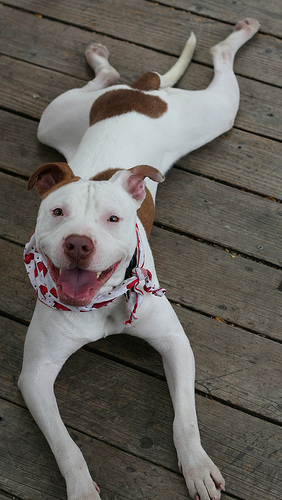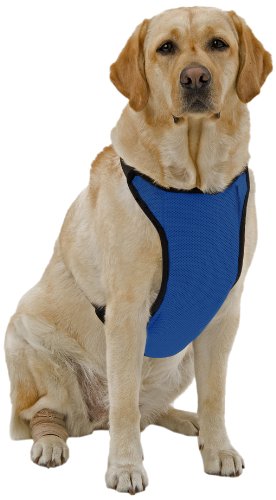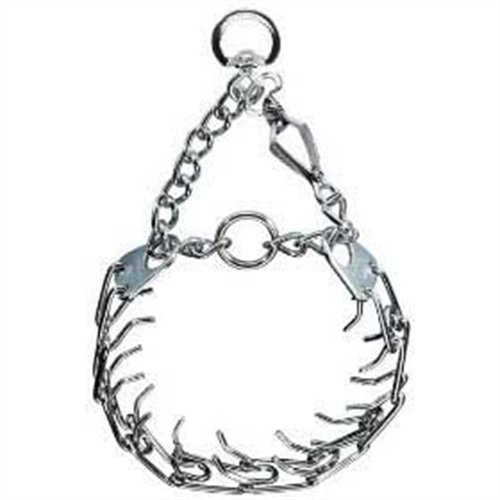
It is an innovative training tool which is humane, safe, and easy to use. While respecting the natural instincts of dogs, it has been scientifically developed to achieve effective control of the dog and to control undesirable behaviours. The head halter acts on the dog’s head, thus controlling its entire body.
The head halter may be worn by the dog at all times provided there is human supervision. It should not be worn at night or in your absence. The control that a head halter offers should be linked to human control. Use it to solve or prevent problems of hyperactivity and disobedience.
These reactions are due to the unknown and to the threat of the dog losing its dominant position. The more a dog likes to have control of certain situations, the more he will fight the head halter. Dogs which are manipulative are also very creative with the behaviours they will use in an attempt to have you remove the halter. These behaviours can include bolting, head shaking, rubbing on the floor, walls and your legs, as well as bucking or simply remaining immobile. These reactions are usually expressed intermittently and they may be quite pronounced at first for a period of about two weeks. The intensity of the reaction will vary in relation to the environment and the people present. The key to your success is a proper fitting. The dog will be more comfortable if he is convinced that he cannot remove the halter, and its acceptance will occur more rapidly.
Fit the halter on your dog and go for an enthusiastic brisk walk, encouraging your dog to follow. Ignore all behaviours of frustration and discomfort, but don’t forget to reward (with praise, a pat and/or food) the absence of these behaviours… Do not pull, and never give a leash correction. The pressure that the halter exerts at the nape of the dog’s neck and on his snout acts as a natural correction. He will learn rapidly by himself that it is far more pleasant to walk at your side.
If your dog pulls, rubs excessively and doesn’t accept the halter, it is possible that this will cause some hair loss on the nose. Don’t worry, the hair will grow back. Keep the halter clean by machine washing it regularly. Keep your dog’s nails as short as possible to prevent injury to his face. Remember that the more your dog fights the halter the more he needs it!!! The head halter is a relatively new tool. Some people will think that your dog is aggressive and that he is wearing a muzzle. Others will find it cruel to use this device. Take the time to educate those people. These views will change as the use of the halter becomes more wide spread.
The head halter is a training tool. Should you want, one day, not to have to use it, you must train your dog not to pull on leash or not to jump on people… Thus, you must reward the absence of these undesirable behaviours. If you remove the snout strap by passing it over the dog’s nose, the halter is transformed into a regular collar. You can then start your walk with the halter on, and remove the nose strap on your way back when the dog is no longer pulling.
The head halter will help you attain the leadership you need to strengthen the bond with your dog and to help you train him to become a better friend.
Julie Sansregret – AHT, Dog trainer
Guides Canins
1313, rue PineRidge,
St-Lazare-de-Vaudreuil, Qué.
J7T 2M7 (450) 424-1469
guidescanins.com
 How to Wash Skunk Off a Dog
I find it absolutely amazing
How to Wash Skunk Off a Dog
I find it absolutely amazing
 The Five Most Common Dog Diseases including Ringworm and Mange
Bone Problems in a Dog
Credit: Wikime
The Five Most Common Dog Diseases including Ringworm and Mange
Bone Problems in a Dog
Credit: Wikime
 10 Reasons To Foster A Dog
10 Reasons To Foster A Dog
If you抎 like to make a re
10 Reasons To Foster A Dog
10 Reasons To Foster A Dog
If you抎 like to make a re
 Cooling Vests For Dogs
Dogs feel the heat just like
Cooling Vests For Dogs
Dogs feel the heat just like
 How To Select And Fit A Prong Collar
A prong collar looks like a
How To Select And Fit A Prong Collar
A prong collar looks like a
Copyright © 2005-2016 Pet Information All Rights Reserved
Contact us: www162date@outlook.com